Abstract
The high incidence of some genetic diseases in certain ethnic groups is important in planning of medical genetic programs. Simple interaction models predict that at least some lethal recessive alleles will have "hitchhiked" to increased frequencies because of linkage to genes whose alleles have been favored by selection for other reasons in certain populations. In the absence of linkage or epistasis with a gene favored by selection, heterozygote advantage for a recessive lethal may produce the same phenomenon. In the hitchhiking model (linkage), the increase in the gene frequency is temporary, but the length of time that the increased gene frequency is at least double the base frequency may be quite long. Changes in gene frequency for the unlinked epistatic model result in a new equilibrium with a possibly higher gene frequency. The most likely chromosomal regions in which hitchhiked lethal recessives would be found are in the vicinity of genes whose allelic frequencies vary substantially among human racial groups (e.g., Gm, Rh, Duffy, lactose tolerance, or HL-A). There will be a hitchhiking effect if recombination distance is less than the selective advantage. The closer the linkage of two loci, the easier hitchhiking effects will be to detect. Hitchhiking is suggested by nonrandom association of the recessive disease and one of the selected markers, as in the case of Gm and cystic fibrosis. However, there is so far insufficient evidence of linkage between them. More pedigree information is necessary than is now available.
Full text
PDF
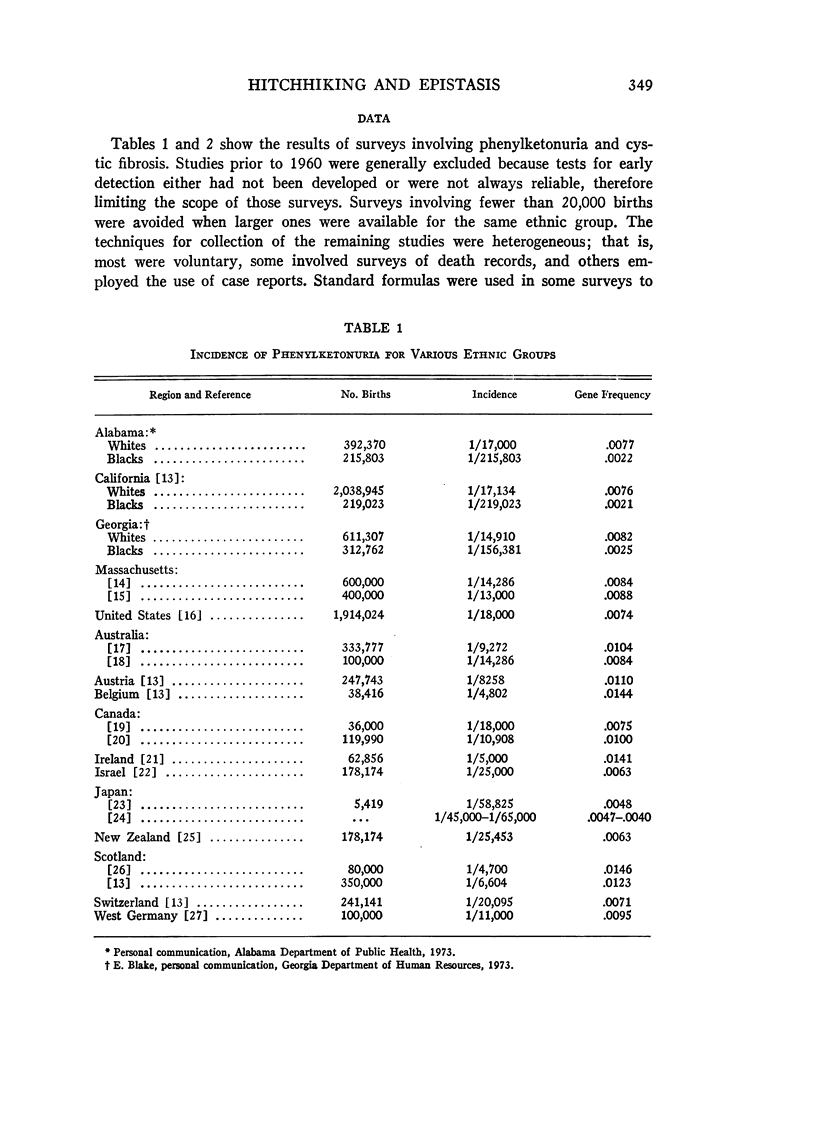
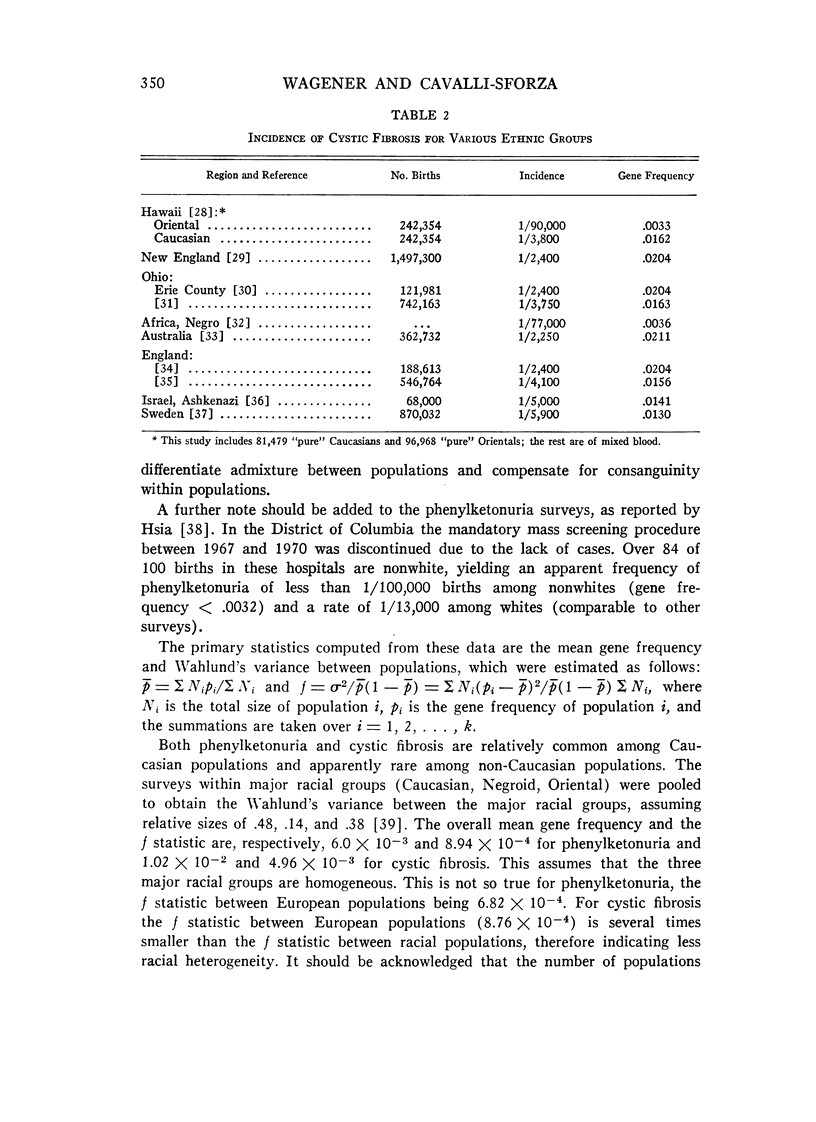
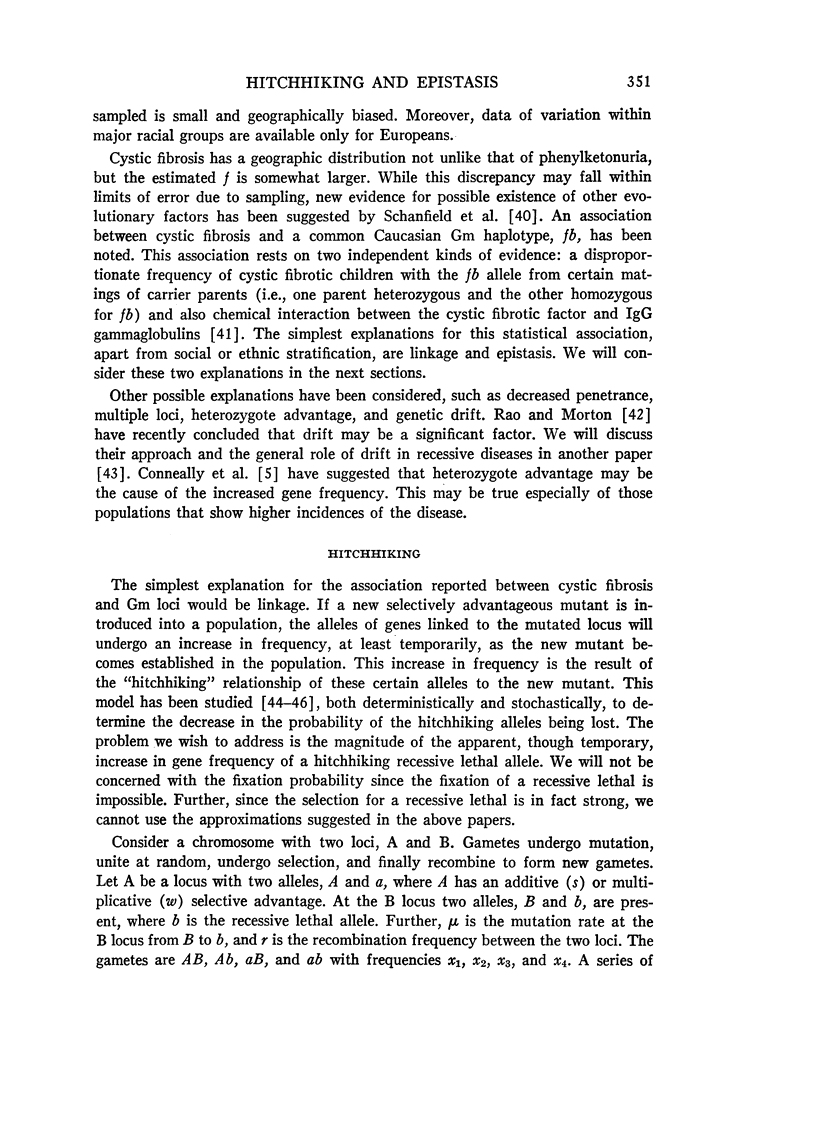
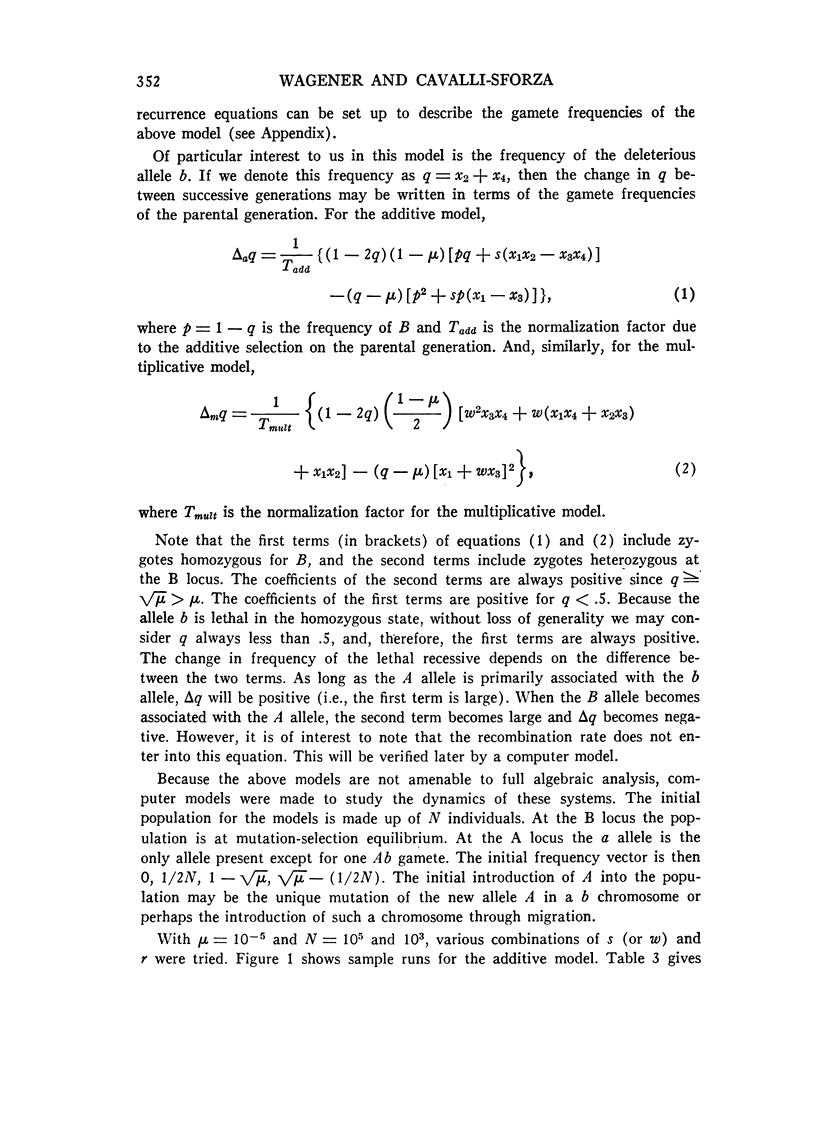
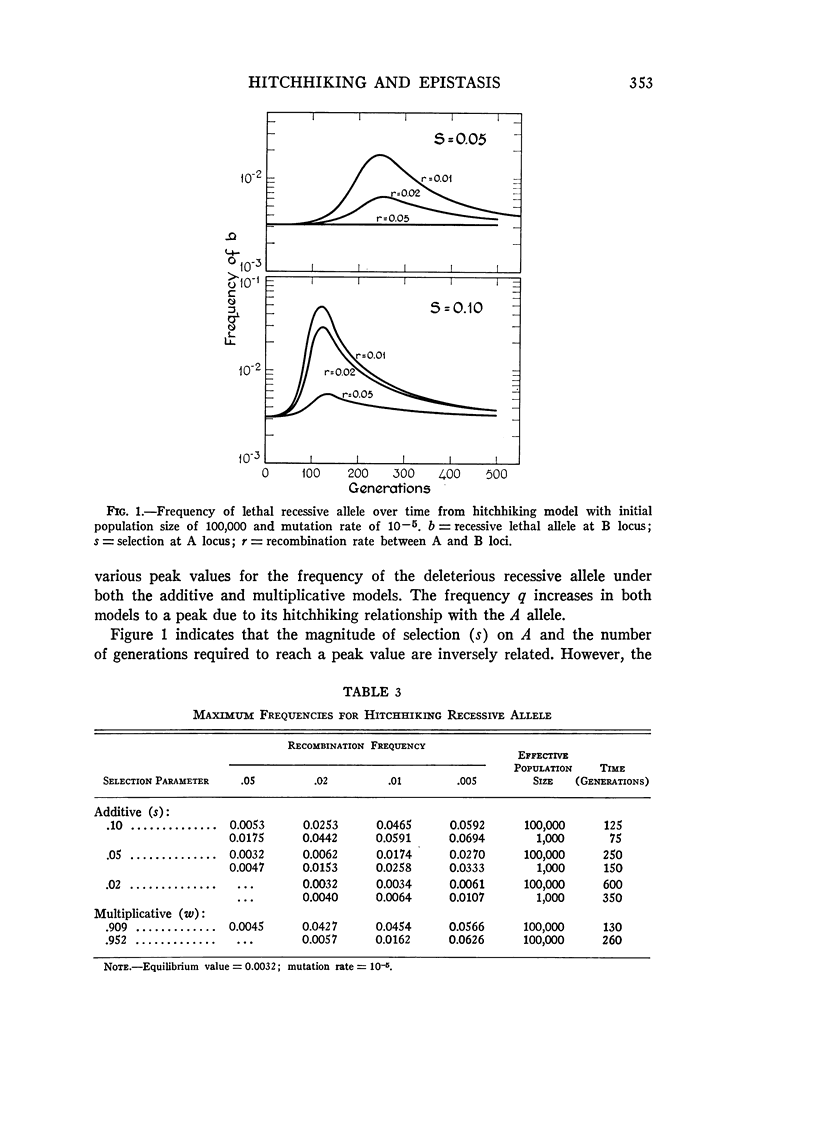
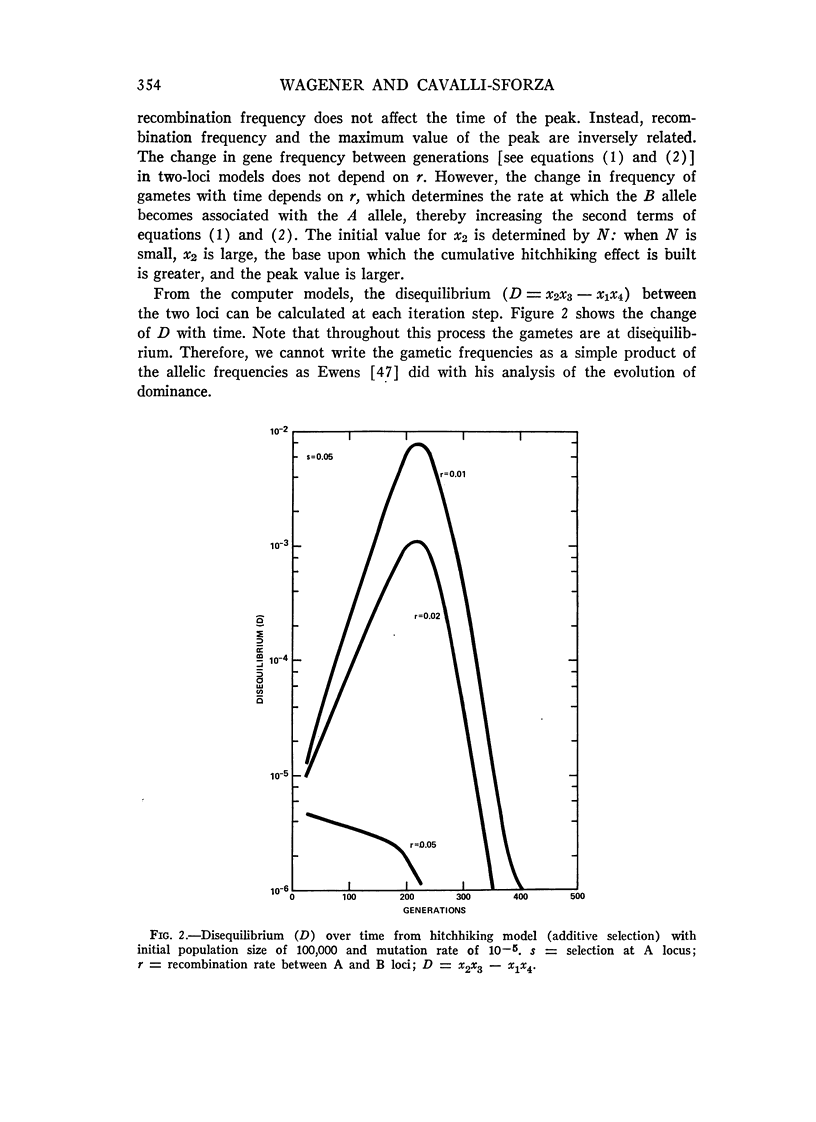
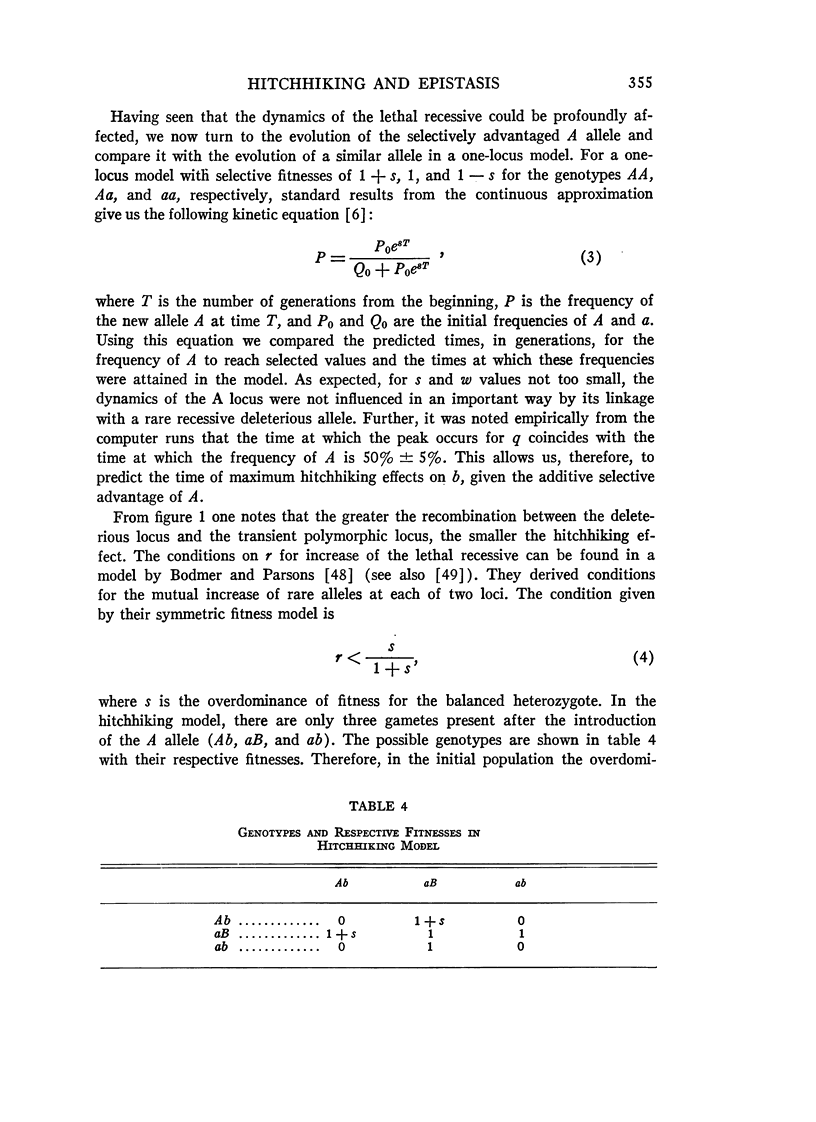
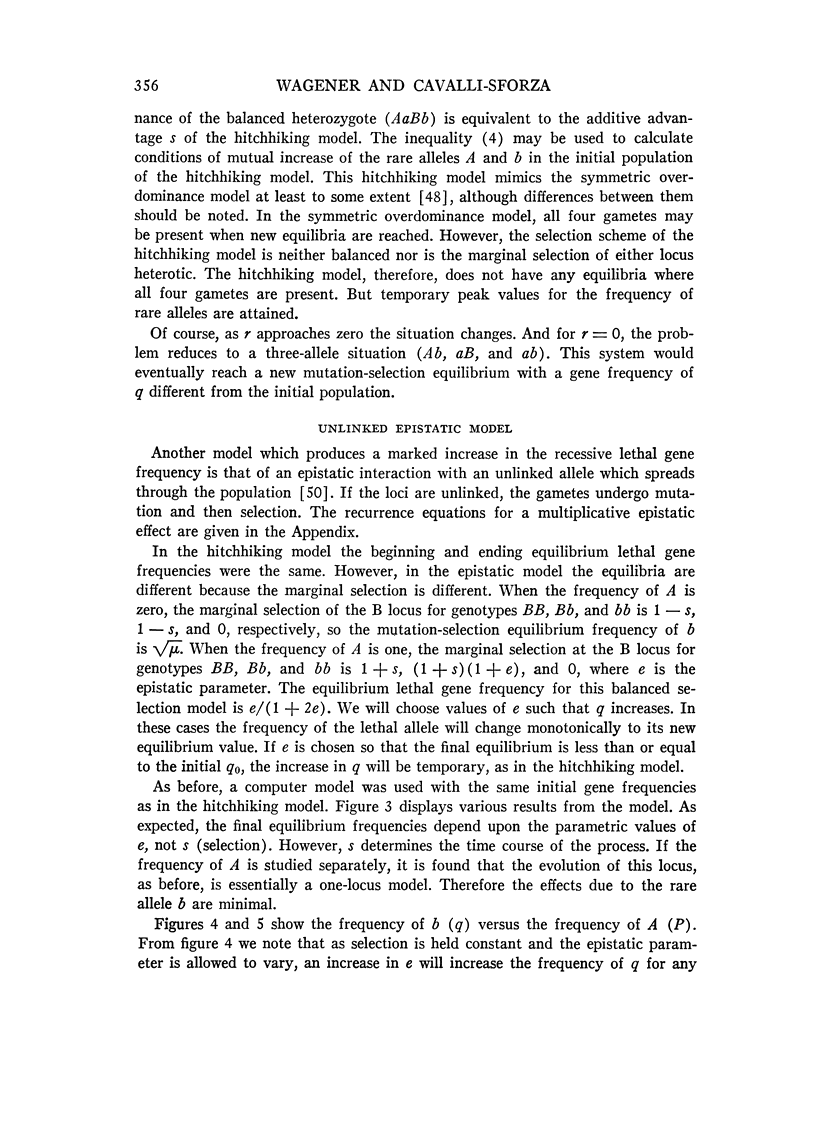
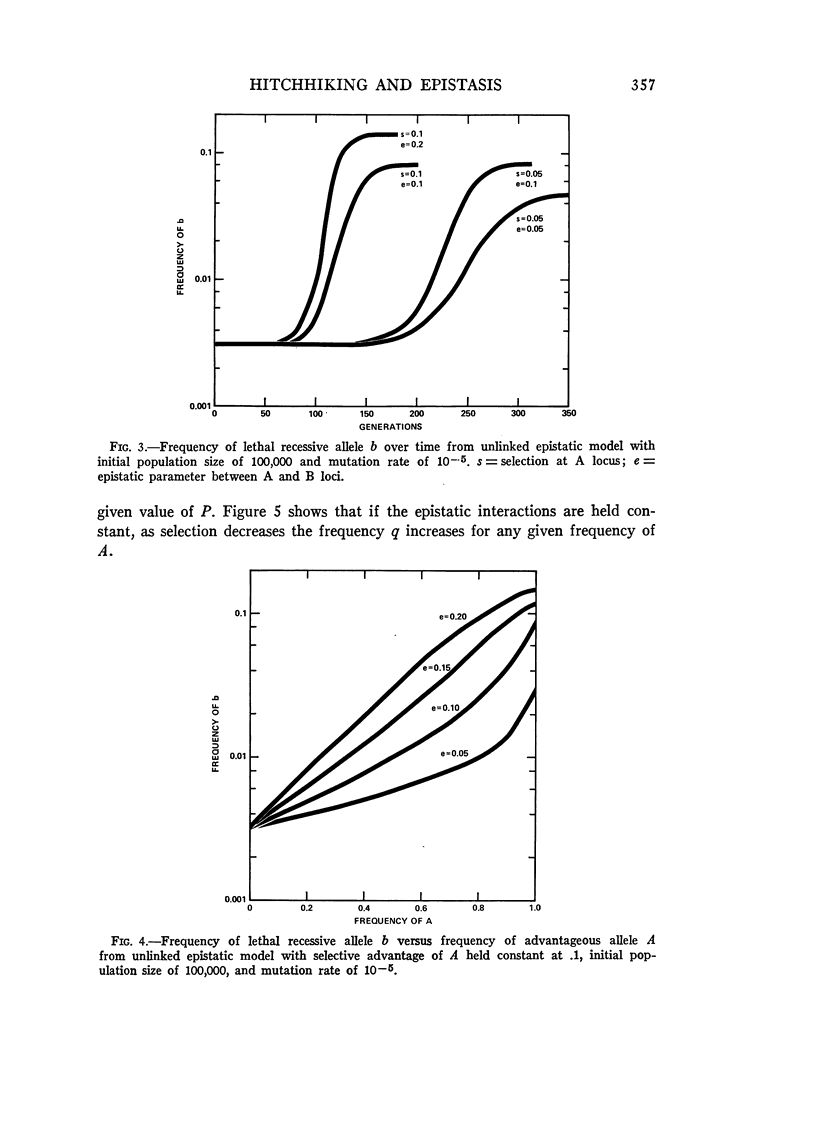
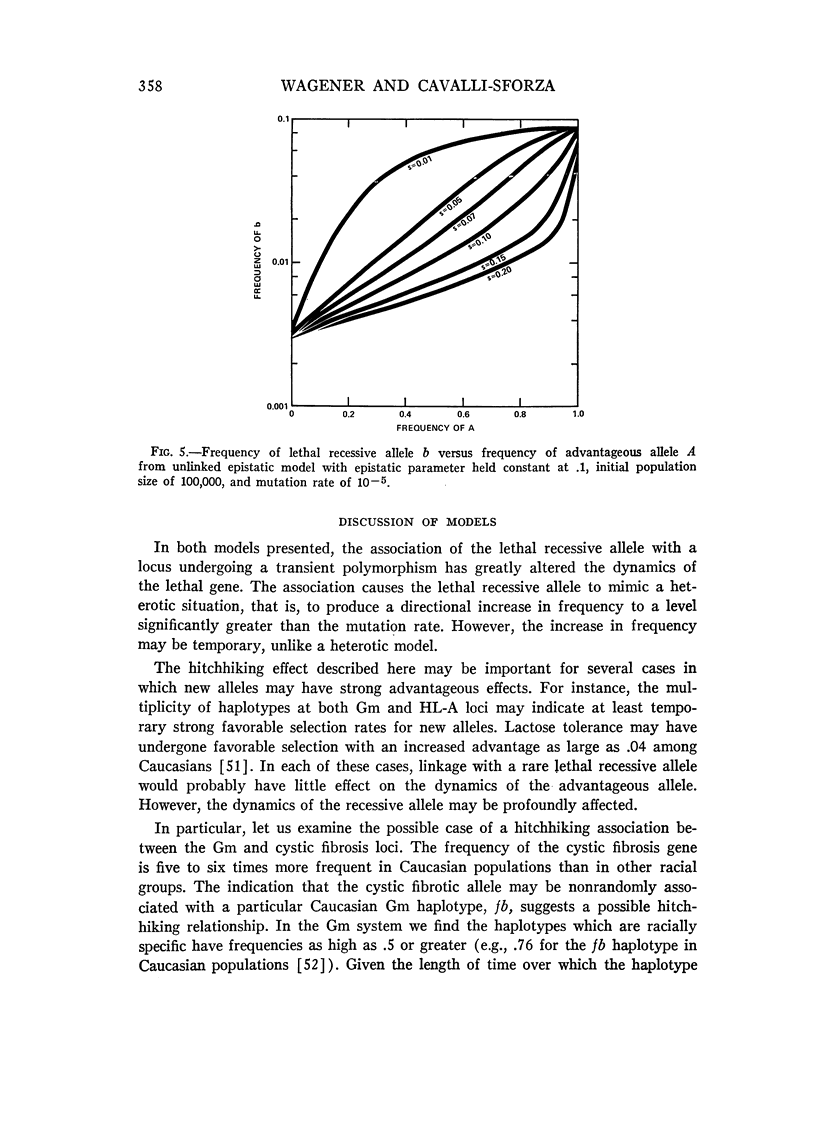
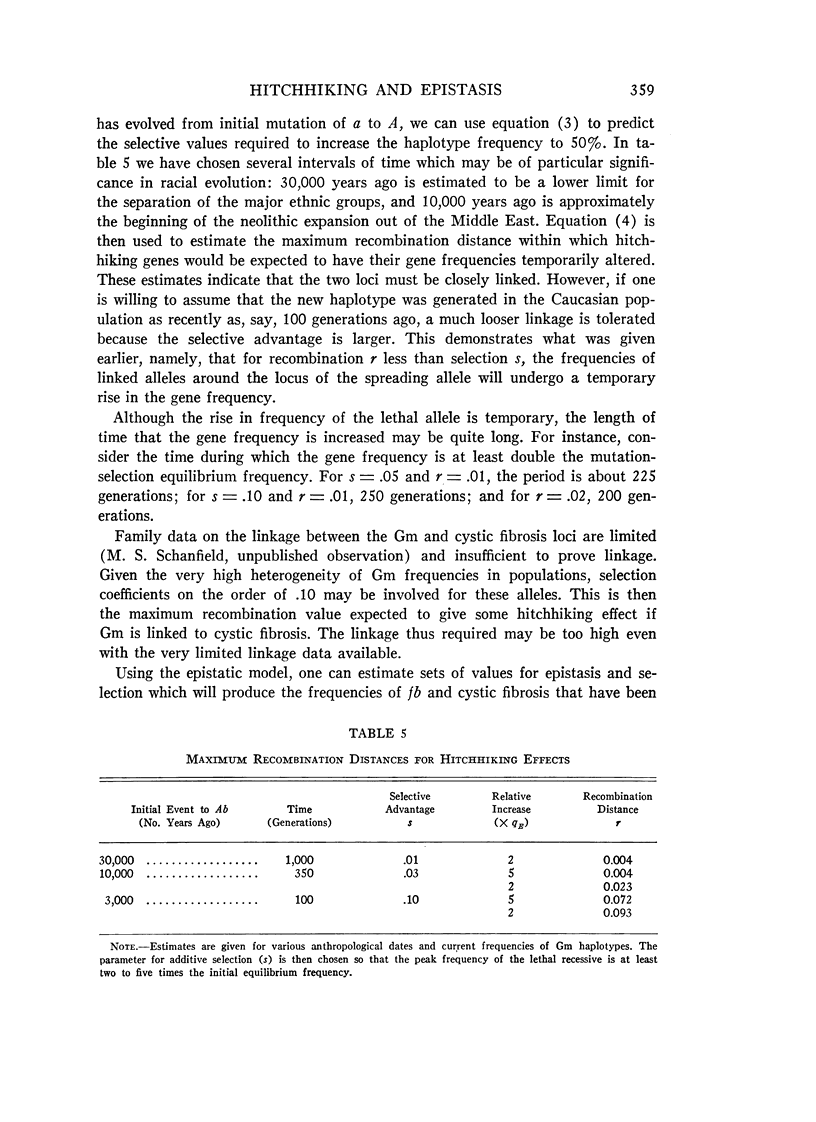
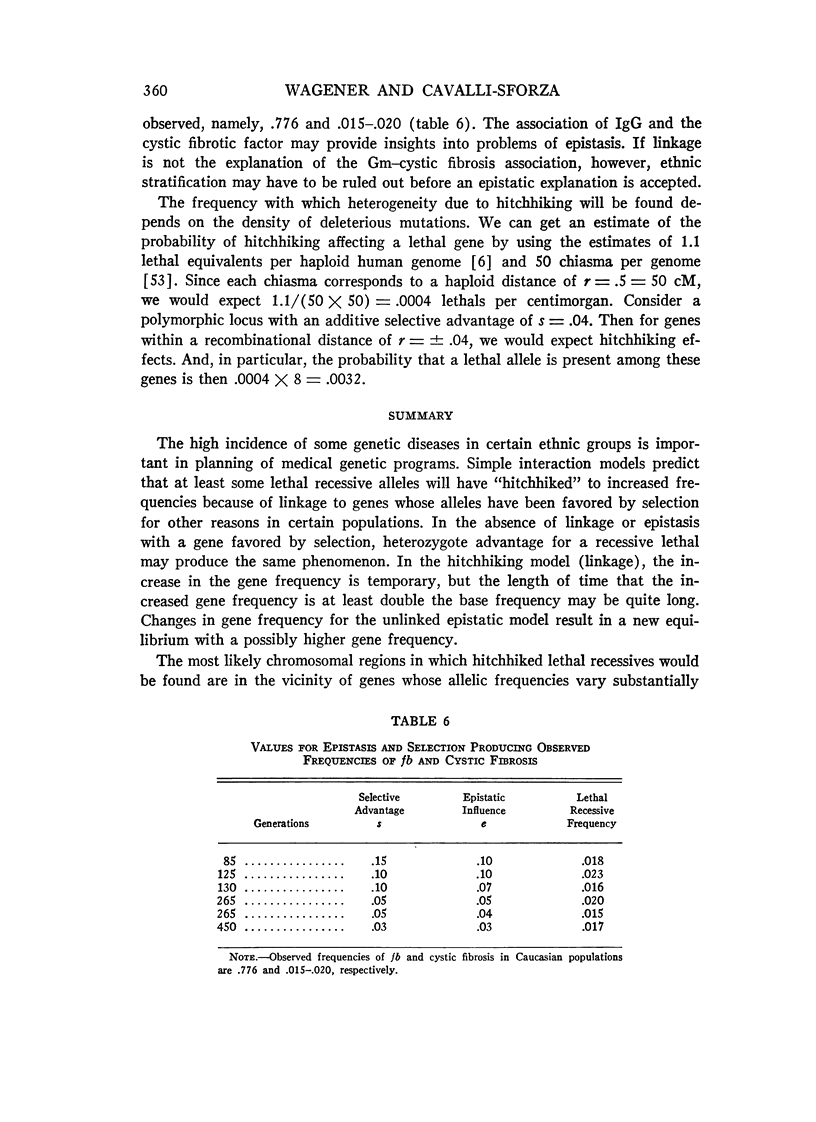
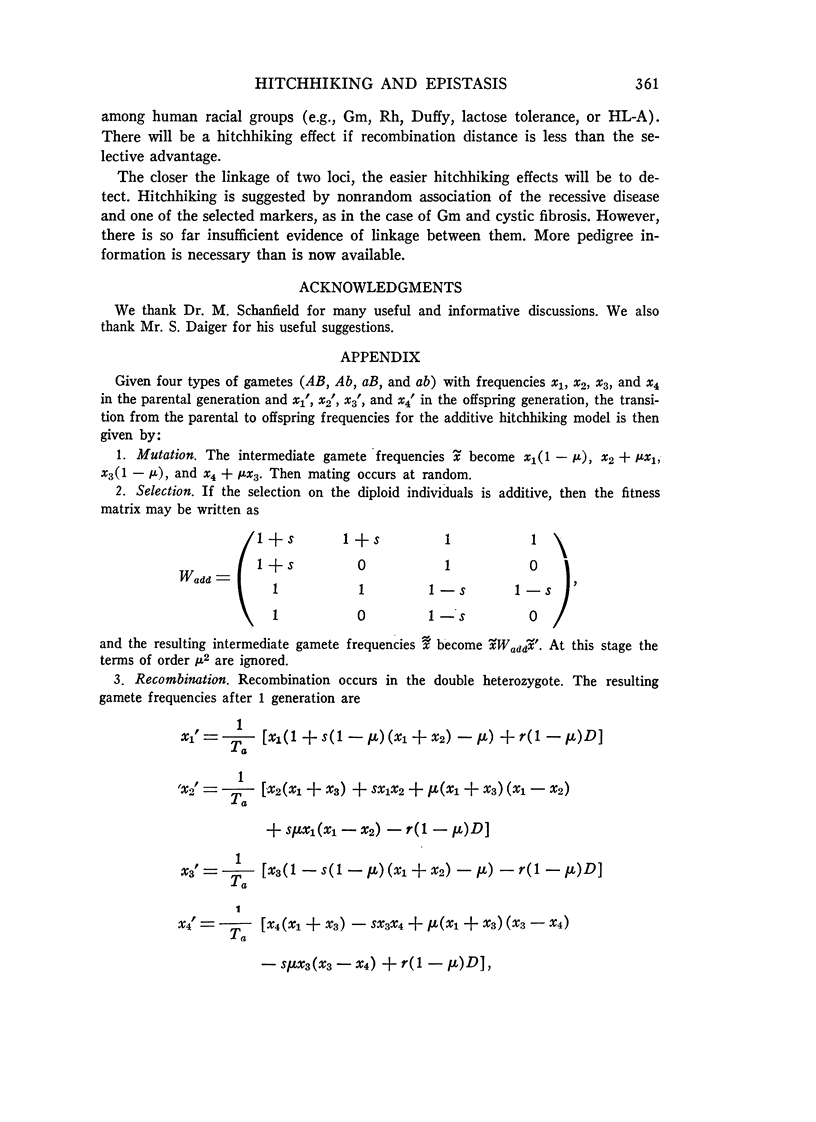
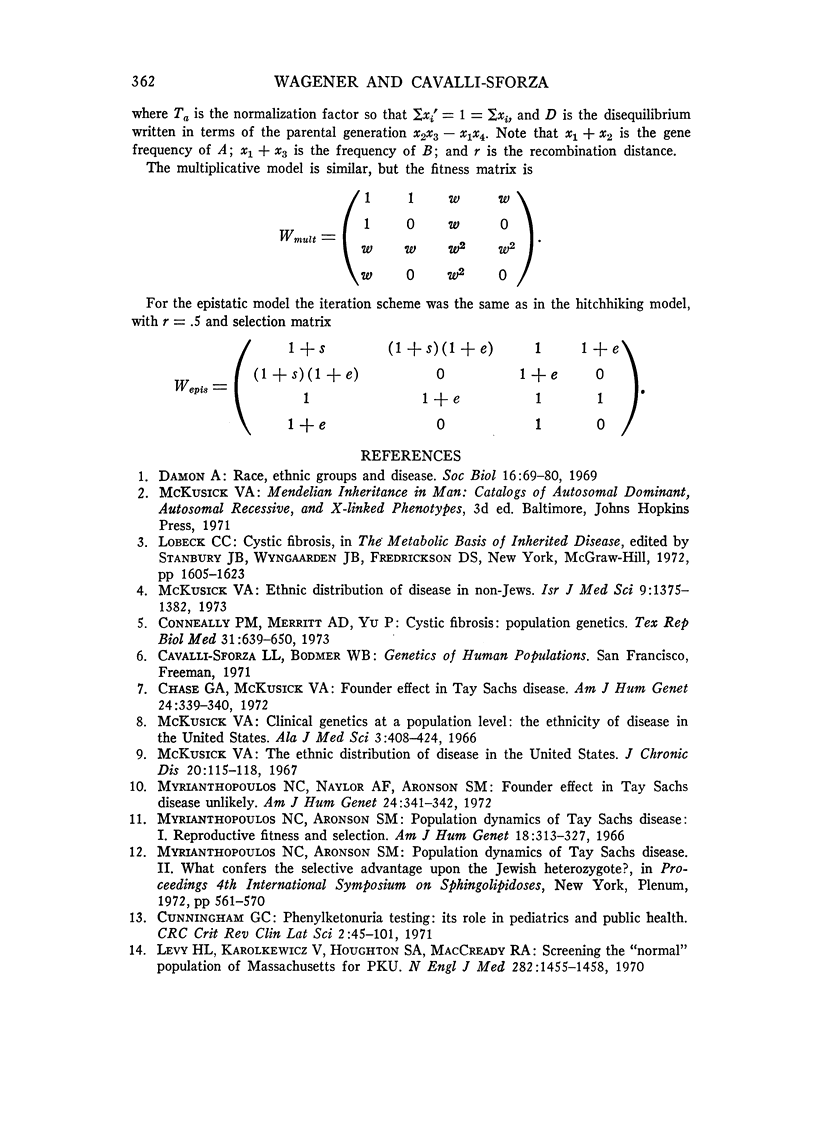
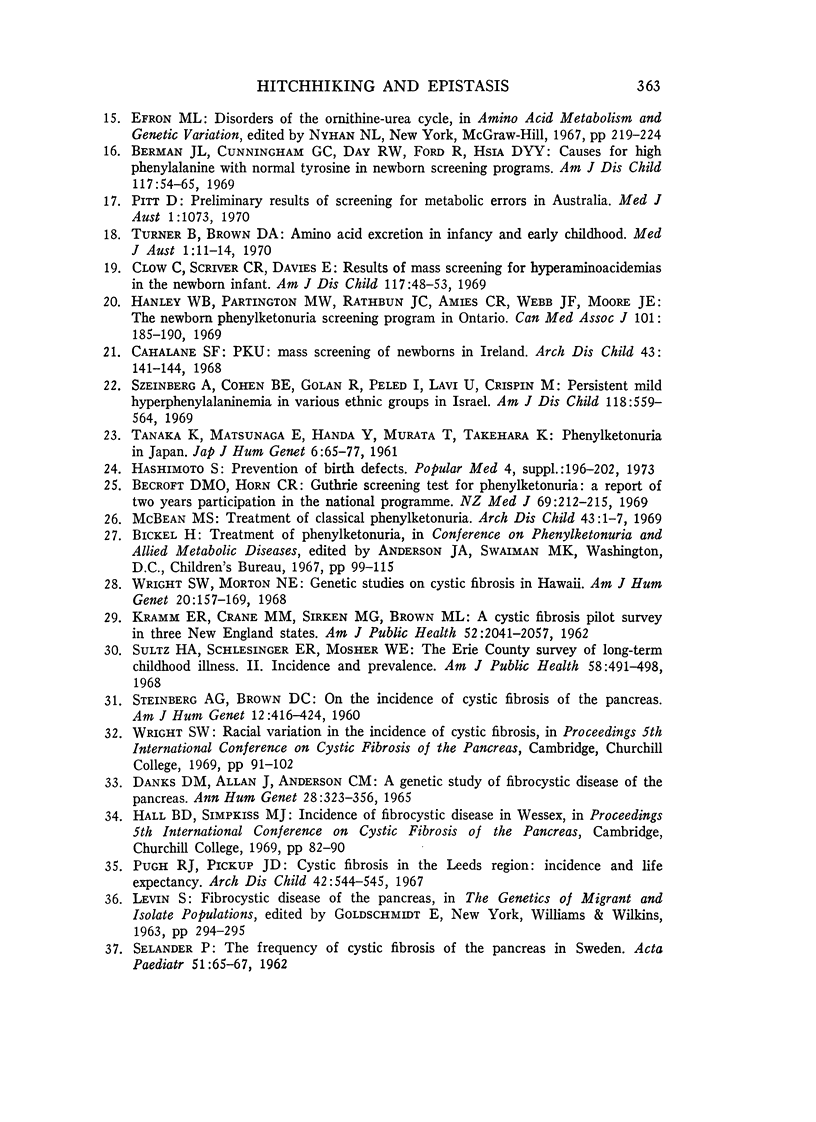
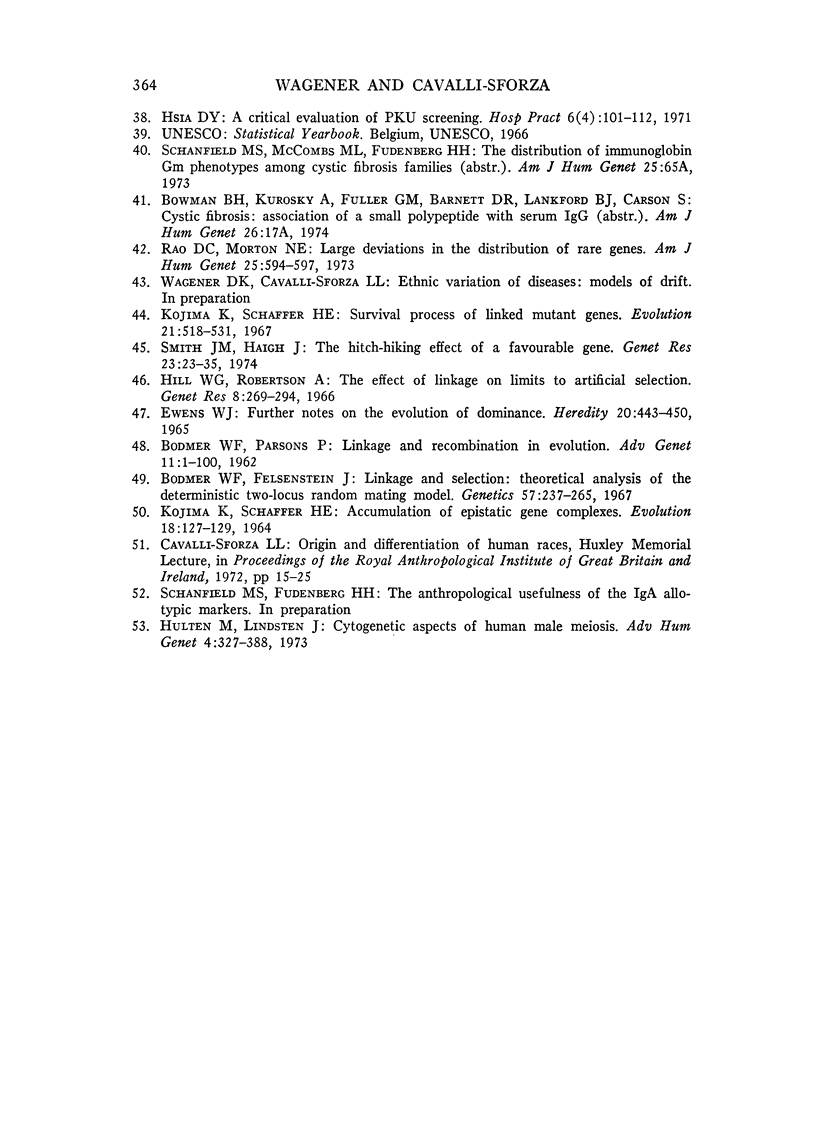
Selected References
These references are in PubMed. This may not be the complete list of references from this article.
- Becroft D. M., Horn C. R. The Guthrie screening test for phenylketonuria: a report on two years participation in the national programme. N Z Med J. 1969 Apr;69(443):212–215. [PubMed] [Google Scholar]
- Berman J. L., Cunningham G. C., Day R. W., Ford R., Hsia D. Y. Causes for high phenylalanine with normal tyrosine in newborn screening programs. Am J Dis Child. 1969 Jan;117(1):54–65. doi: 10.1001/archpedi.1969.02100030056006. [DOI] [PubMed] [Google Scholar]
- Bodmer W. F., Felsenstein J. Linkage and selection: theoretical analysis of the deterministic two locus random mating model. Genetics. 1967 Oct;57(2):237–265. doi: 10.1093/genetics/57.2.237. [DOI] [PMC free article] [PubMed] [Google Scholar]
- Cahalane S. F. Phenylketonuria. Mass screening of newborns in Ireland. Arch Dis Child. 1968 Apr;43(228):141–144. doi: 10.1136/adc.43.228.141. [DOI] [PMC free article] [PubMed] [Google Scholar]
- Chase G. A., McKusick V. A. Controversy in human genetics: founder effect in Tay-Sachs disease. Am J Hum Genet. 1972 May;24(3):339–340. [PMC free article] [PubMed] [Google Scholar]
- Clow C., Scriver C. R., Davies E. Results of mass screening for hyperaminoacidemias in the newborn infant. Am J Dis Child. 1969 Jan;117(1):48–53. doi: 10.1001/archpedi.1969.02100030050005. [DOI] [PubMed] [Google Scholar]
- Conneally P. M., Merritt A. D., Yu P. L. Cystic fibrosis: population genetics. Tex Rep Biol Med. 1973 Winter;31(4):639–650. [PubMed] [Google Scholar]
- Cunningham G. C. Phenylketonuria testing--its role in pediatrics and public health. CRC Crit Rev Clin Lab Sci. 1971 Jan;2(1):45–101. doi: 10.3109/10408367109151304. [DOI] [PubMed] [Google Scholar]
- Damon A. Race, ethnic group, and disease. Soc Biol. 1969 Jun;16(2):69–80. doi: 10.1080/19485565.1969.9987804. [DOI] [PubMed] [Google Scholar]
- Hill W. G., Robertson A. The effect of linkage on limits to artificial selection. Genet Res. 1966 Dec;8(3):269–294. [PubMed] [Google Scholar]
- Hultén M., Lindsten J. Cytogenetic aspects of human male meiosis. Adv Hum Genet. 1973;4:327–387. doi: 10.1007/978-1-4615-8261-8_5. [DOI] [PubMed] [Google Scholar]
- KRAMM E. R., CRANE M. M., SIRKEN M. G., BROWN M. L. A cystic fibrosis pilot survey in three New England states. Am J Public Health Nations Health. 1962 Dec;52:2041–2057. doi: 10.2105/ajph.52.12.2041. [DOI] [PMC free article] [PubMed] [Google Scholar]
- Levy H. L., Karolkewicz V., Houghton S. A., MacCready R. A. Screening the "normal" population in Massachusetts for phenylketonuria. N Engl J Med. 1970 Jun 25;282(26):1455–1458. doi: 10.1056/NEJM197006252822604. [DOI] [PubMed] [Google Scholar]
- MCBean M. S., Stephenson J. B. Treatment of classical phenylketonuria. Arch Dis Child. 1968 Feb;43(227):1–7. doi: 10.1136/adc.43.227.1. [DOI] [PMC free article] [PubMed] [Google Scholar]
- McKusick V. A. Clinical genetics at a populational level. The ethnicity of disease in the United States. Ala J Med Sci. 1966 Oct;3(4):408–424. [PubMed] [Google Scholar]
- McKusick V. A. Ethnic distribution of disease in non-Jews. Isr J Med Sci. 1973 Sep-Oct;9(9):1375–1382. [PubMed] [Google Scholar]
- McKusick V. A. The ethnic distribution of disease in the United States. J Chronic Dis. 1967 Mar;20(3):115–118. doi: 10.1016/0021-9681(67)90045-8. [DOI] [PubMed] [Google Scholar]
- Myrianthopoulos N. C., Aronson S. M. Population dynamics of Tay-Sachs disease. I. Reproductive fitness and selection. Am J Hum Genet. 1966 Jul;18(4):313–327. [PMC free article] [PubMed] [Google Scholar]
- Myrianthopoulos N. C., Naylor A. F., Aronson S. M. Founder effect in Tay-Sachs disease unlikely. Am J Hum Genet. 1972 May;24(3):341–342. [PMC free article] [PubMed] [Google Scholar]
- Pitt D. Preliminary results of screening for metabolic errors in Australia. Med J Aust. 1970 May 23;1(21):1073–1073. [PubMed] [Google Scholar]
- Pugh R. J., Pickup J. D. Cystic fibrosis in the Leeds region: incidence and life expectancy. Arch Dis Child. 1967 Oct;42(225):544–545. doi: 10.1136/adc.42.225.544. [DOI] [PMC free article] [PubMed] [Google Scholar]
- Rao D. C., Morton N. E. Large deviations in the distribution of rare genes. Am J Hum Genet. 1973 Nov;25(6):594–597. [PMC free article] [PubMed] [Google Scholar]
- SELANDER P. The frequency of cystic fibrosis of the panceas in Sweden. Acta Paediatr. 1962 Jan;51:65–67. doi: 10.1111/j.1651-2227.1962.tb06510.x. [DOI] [PubMed] [Google Scholar]
- Smith J. M., Haigh J. The hitch-hiking effect of a favourable gene. Genet Res. 1974 Feb;23(1):23–35. [PubMed] [Google Scholar]
- Steinberg A. G., Brown D. C. On the Incidence of Cystic Fibrosis of the Pancreas. Am J Hum Genet. 1960 Dec;12(4 Pt 1):416–424. [PMC free article] [PubMed] [Google Scholar]
- Sultz H. A., Schlesinger E. R., Mosher W. E. The Erie County survey of long-term childhood illness. II. Incidence and prevalence. Am J Public Health Nations Health. 1968 Mar;58(3):491–498. doi: 10.2105/ajph.58.3.491. [DOI] [PMC free article] [PubMed] [Google Scholar]
- Szeinberg A., Cohen B. E., Golan R., Peled I., Lavi U., Crispin M. Persistent mild hyperphenylalaninemia in various ethnic groups in Israel. Am J Dis Child. 1969 Oct;118(4):559–564. doi: 10.1001/archpedi.1969.02100040561003. [DOI] [PubMed] [Google Scholar]
- TANAKA K., MATSUNAGA E., HANDA Y., MURATA T., TAKEHARA K. Phenylketonuria in Japan. Jinrui Idengaku Zasshi. 1961 Oct;6:65–77. [PubMed] [Google Scholar]
- The newborn phenylketonuria screening program in Ontario. Can Med Assoc J. 1969 Aug 23;101(4):185–190. [PMC free article] [PubMed] [Google Scholar]
- Turner B., Brown D. A. Aminoacid excretion in infancy and early childhood. A survey of 100,000 infants. Med J Aust. 1970 Jan 3;1(1):11–14. [PubMed] [Google Scholar]
- Wright S. W., Morton N. E. Genetic studies on cystic fibrosis in Hawaii. Am J Hum Genet. 1968 Mar;20(2):157–169. [PMC free article] [PubMed] [Google Scholar]


